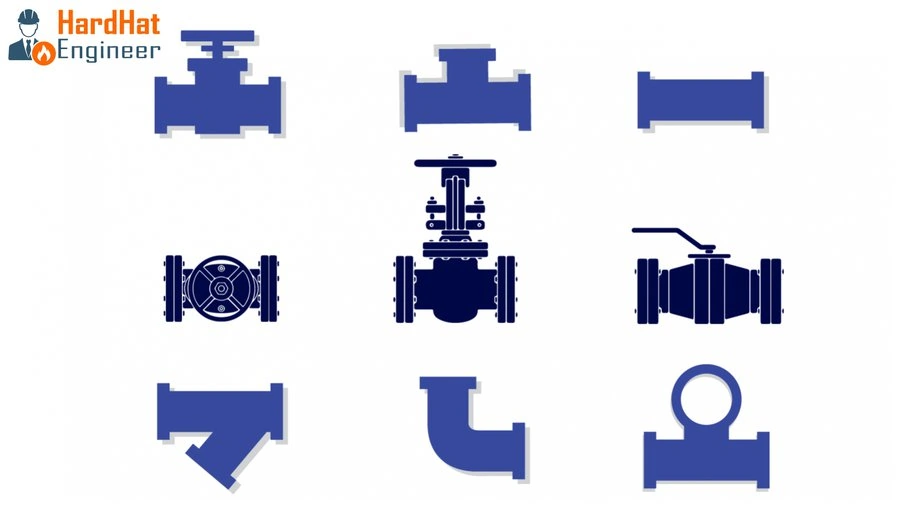Welcome to hardhatengineer. In this video, you will learn about What is the differences between ASME and ASTM materials and how they are named.
At the end of the video, you will not mix up SA106 Gr B with A106 Gr B. So watch the video till the end.
Please like and share this video, and don’t forget to subscribe because that way, you will get a new video notification.
Let’s start with the video.
Difference between ASME SA and ASTM A
Ever get confused between ASME SA 106 Grade B and ASTM A 106 Grade B? Let’s clear this confusion today.
While working in Oil and Gas or any process industry, you will come across various material grades such as A106 GrB, A105 GrB, A234 WCB, etc. Here, you can see the most common materials used regularly in piping or equipment manufacturing.
Now let’s see what all these nomenclatures, such as ASTM, A, 312, TP, and 304 say to us about the Stainless Steel Pipe material ASTM A 312 TP304.
ASTM, ASME, DIN, and MSS all these standards list the materials based on their known chemical composition, manufacturing processes, mechanical strength, etc.
ASTM Standard gives various details of materials like manufacturing process, Grades, Chemical Composition, and Mechanical Properties. Now, look at the example given here.
Piping Component Quiz – Test yourself, Take This Quiz
Unlock New Skills with Our Best Selling Online Courses
ASTM Material Naming Method
I have taken ASTM A 312 TP 304 as an example.
- ASTM A 312 TP 304
- ASTM: Applicable Standard
- A: Ferrous
- 312: Manufacturing Process No.
- TP: Tubular Product
- 304: Grade
Here you can see a few more examples of the materials.
- A 234 GR WPB : Wrought Product Grade B
- A 350 LF 2 : Low Temperature Forging Grade 2
- A 216 WCB : Weldable Casting Grade B
- A 335 P 11 : Pipe Grade 11
- A 182 Gr F11 : Forging Grade 11
- A 351 Gr CF 8 : Centrifugal Cast, Carbon % – 0.08%
- A 351 Gr CF 3 : Centrifugal Cast, Carbon % – 0.03%
- A 351 Gr CF 8M : Centrifugal Cast, Carbon % – 0.08%, Mo
- A 351 Gr CF 3M : Centrifugal Cast, Carbon % – 0.03%, Mo
From this list, you now have a good idea about what these alphabets and numbers indicate in the ASTM material. But what about ASME?
ASME Code accepts the ASTM materials with some additional specified properties. So if your equipment is manufactured according to the ASME Boiler Pressure vessel code, you will see the list of materials similar to the above but with small modifications, as shown here.
ASME Material Naming Method
Here again, I am taking Stainless Steel grade 312 TP 304. But this time it is for ASME compliance.
- ASME SA 312 TP 304
- ASME : Applicable Standard
- S : ASME approved Material
- A : Ferrous
- 312 : Manufacturing Process No.
- TP : Tubular Product
- 304 : Grade
Can you spot the difference?
In ASME material, it is SA312 and not just A312. So when prefix S is added in front of material type, it indicates ASME approved material. So, now you know the difference between A106 and SA106.
ASME has adopted ASTM material with additional requirements; that is why this numbering differs slightly.
For some material grades, there is no difference between ASTM and ASME. However, for some, there are certain additional requirements. To meet the ASME boiler pressure vessel code, you must take care of these differences during the inspection of the material.
So many material manufacturers produce dual marking on the material so that it can be used for both ASME and ASTM.
Now, you know that
This is the end of the video. Please visit my website hardhatengineer.com to learn more about piping material. And don’t forget to subscribe. See you soon with the next video. Goodbye, take care.
Are You Piping Components Master?



